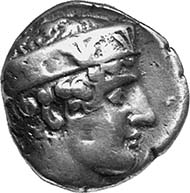by courtesy of Hans Voegtli
For us Olympia seems to be equivalent to the peaceful contest of all nations. In referring to ancient tradition we forget entirely that the sanctuary had been contested for centuries.
Model of the sanctuary of Olympia. Photo: Steve Swayne / Wikipedia.
Originally Olympia belonged to Triphylia, a part of Arcadia that was controlled by Pisa. The inhabitants of neighboring Skillus, another town of Triphylia, built the first important temple probably in honor of Zeus, lord of the sanctuary. It was a building made of limestone with walls of brick and columns of wood. Its entrance was adjusted to the famous ash altar of Olympia. This altar consisted of the ashes of Zeus’ burned victims and at the time of Pausanias it measured 22 feet (= 7 meters).
Triphylia and the environs of Olympia were fertile, extraordinarily fertile to be accurate. And this fertility roused the greediness of the neighbors: About 580 BC the Eleans, a people living in the North of the valley of the Alpheios, conquered Olympia with the help of the Spartans. Pisa was destroyed and Olympia was put under Elean control. The coins issued in Olympia show henceforth the name of the conquerors: F-A for Faleion.
OLYMPIA (Elis). Stater, 420-384 BC. Head of Hera r., wearing tall stephanos showing palmettes and tendrils. 12,08 g. Seltman 81, 280 (same die).
The taint of having taken Olympia by force was clung to the Eleans. Therefore they tried to extinguish every remembrance of the former holders. But they couldn’t destroy the temple the inhabitants of Triphylia had built. It would have been a sacrilege to pull down the present to the god Zeus.
In 476 the rulers of Olympia got the chance to improve their image. The joint fight against the Persians had convinced the Greeks that the eternal quarrels had to be ended. Therefore the Greek cities decided to establish an arbitration court in Olympia to act as mediator in cases of conflict. We possess a sheet bronze, on which two arbitration awards were engraved that were rendered within the years between 476 and 472. From history we know that Olympia had no success in maintaining peace in the long run. But in 476, the Eleans felt to be in the center of Greek politics. Of course they wanted to demonstrate their new importance. Therefore they decided to erect a new temple of Zeus. It became a marvelous building in marble, that housed later on the precious gold ivory statue of Zeus made by Phideas set up as an acknowledgement for Zeus’ help against the inhabitants of Triphylia.
The ruins of the temple dedicated to Zeus by the Eleans. Foto: Imehling / Wikipedia.
Therefore Zeus suddenly had two temples in Olympia: The magnificent marble temple of the Eleans and the small, modest building of the former owners of the sanctuary. One problem still was left: The age of the second one bore witness to everybody that the Eleans had not been the controllers of the sanctuary from the very beginning. But the Eleans found a solution: They changed the dedication of the old temple to Hera, who had no important cult in Olympia until then. As a result, the second temple lost its importance for Olympia. After all it was Zeus not Hera who was the focus of the Olympic rituals.
Hera received an upgrading in Olympia due to this new dedication. She now was placed at the side of Zeus. Coins – like the one that is shown above – were minted showing her picture. These issues were certainly not produced in the temples of Zeus or Hera to serve in the money circulation during the Olympic games. They were minted at an unknown place to pay for the costs of the sanctuary, which the Eleans had to cover.
Pausanias V, 16 relates that in his time – meaning more than half a millenium later – Hera was integrated completely in the Olympic calendar of ceremonies. Every four years the Heraia were held, a festival in honor of Hera. During the Heraia Hera received – similar to Athena in Athens – a new robe. In addition to that a race for women was organized.
By the way, the Eleans couldn’t enjoy their triumph in the long run. As early as 402/1 the Spartans subjected the Eleans. In 365 the latter had to hand over the control over Olympia to the Arcadians. After a sacrilegious invasion of Olympia during (!) the games of 364 the Eleans could once again regain the rule. But the slow decay of Olympia as the center of the Greeks had already started. The heydays of the Olympic gods had passed away and the divine humans replaced them.
S. Lauffer, Griechenland. Lexikon der historischen Stätten, München 1989.
C. Seltman, The Temple Coins of Olympia, Nomisma 8, 9, 11 (1913, 1914, 1921); Ausgabe Cambridge 1921.
C. Seltman, The Katoché Hoard of Elean Coins, NC 1951.
U. Sinn, Olympia. Kult, Sport und Fest in der Antike, München 1996.









